Output Characteristics of External-Cavity Mode-Hop-Free Tunable Laser Source in C+L Band
Abstract
:1. Introduction
2. Configuration of the EC-TLS and Device Characteristics
3. Results and Discussion
4. Conclusions
Author Contributions
Funding
Institutional Review Board Statement
Informed Consent Statement
Data Availability Statement
Conflicts of Interest
References
- Maiman, T.H. Stimulated optical radiation in ruby. Nature 1960, 187, 493–494. [Google Scholar] [CrossRef]
- Lv, Z.W.; Liu, Z.Z.; Chen, H.; Jin, D.; Hao, X.; Fan, W.Q.; Wang, Y.L.; Bai, Z.X. Review of multi-wavelength laser technology based on crystalline Raman conversion (invited). Infrared Laser Eng. 2023, 52, 20230420. [Google Scholar]
- Shank, C.; Bjorkholm, J.; Kogelnik, H. Tunable distributed-feedback dye laser. Appl. Phys. Lett. 1971, 18, 395–396. [Google Scholar] [CrossRef]
- Chen, H.; Cui, Y.; Li, X.; Zhang, B.; Cai, Y.; Ding, J.; Qi, Y.Y.; Yan, B.Z.; Wang, Y.L.; Lv, Z.W.; et al. High-power dual-wavelength intracavity diamond Raman laser. Funct. Diam. 2023, 3, 2282527. [Google Scholar] [CrossRef]
- Zhang, Y.K.; Chen, H.; Bai, Z.A.; Pang, Y.J.; Wang, Y.L.; Lv, Z.W.; Bai, Z.X. Multi-wavelength red diamond Raman laser. Infrared Laser Eng. 2023, 52, 20230329. [Google Scholar]
- Bai, Z.X.; Zhao, Z.A.; Tian, M.H.; Jin, D.; Pang, Y.J.; Li, S.S.; Yan, X.S.; Wang, Y.L.; Lv, Z.W. A comprehensive review on the development and applications of narrow-linewidth lasers. Microwave Opt. Technol. Lett. 2022, 64, 2244–2255. [Google Scholar] [CrossRef]
- Chen, Y.F.; Tan, B.W.; Jin, D.; Chen, B.; Bai, Z.X.; Wang, K.; Wang, Y.L.; Lv, Z.W. Characteristics and suppression of beam distortion in a high repetition rate nanosecond stimulated Brillouin scattering phase conjugation mirror. High Power Laser Sci. Eng. 2024, 12, e20. [Google Scholar] [CrossRef]
- Chen, B.; Bai, Z.X.; Zhao, G.J.; Wang, Y.L.; Lv, Z.W. Generation of high-efficiency hundred-millijoule stimulated Brillouin scattering in fused silica. Infrared Laser Eng. 2023, 52, 20230421. [Google Scholar]
- Kasai, K.; Nakazawa, M.; Tomomatsu, Y.; Endo, T. 1.5 μm, mode-hop-free full C-band wavelength tunable laser diode with a linewidth of 8 kHz and a RIN of −130 dB/Hz and its extension to the L-band. Opt. Express 2017, 25, 22113–22124. [Google Scholar] [CrossRef]
- Sheng, L.W.; Ge, C.L.; Cao, Q.T.; Huang, L.; Zhao, Z.A.; Li, L.F.; Qiao, S.; Zhang, A.G.; Wei, Y.; Jin, H.; et al. Wide-range external-cavity tunable semiconductor laser with mode-hopping free. Infrared Laser Eng. 2023, 52, 20230374. [Google Scholar]
- Mroziewicz, B. External cavity wavelength tunable semiconductor lasers-a review. Opto-Electronics Rev. 2008, 16, 347–366. [Google Scholar] [CrossRef]
- Zhang, A.G.; Qiao, S.; Sheng, L.W.; Huang, L.; Liu, Z.M.; Ju, J.W.; Zhang, Z.H.; Yin, B.Q.; Li, P.; Liu, J.Q.; et al. Study on external cavity diode laser with a wide mode-hopping free tuning range. Front. Phys. 2022, 10, 1093179. [Google Scholar] [CrossRef]
- McGrew, W.F.; Zhang, X.; Fasano, R.J.; Schäffer, S.A.; Beloy, K.; Nicolodi, D.; Brown, R.C.; Hinkley, N.; Milani, G.; Schioppo, M.; et al. Atomic clock performance enabling geodesy below the centimetre level. Nature 2018, 564, 87–90. [Google Scholar] [CrossRef] [PubMed]
- Schioppo, M.; Brown, R.C.; McGrew, W.F.; Hinkley, N.; Fasano, R.J.; Beloy, K.; Yonn, T.H.; Milani, G.; Nicolodi, D.; Sherman, J.A.; et al. Ultrastable optical clock with two cold-atom ensembles. Nat. Photonics 2017, 11, 5163–5166. [Google Scholar] [CrossRef]
- Zhang, L.B.; Liu, T.; Chen, L.; Xu, G.J.; Jiang, C.H.; Liu, J.; Zhang, S.G. Development of an interference filter-stabilized external-cavity diode laser for space applications. Photonics 2020, 7, 12. [Google Scholar] [CrossRef]
- Chi, M.J.; Jensen, O.B.; Petersen, P.M. Tuning range and output power optimization of an external-cavity GaN diode laser at 455 nm. Appl. Optics 2016, 55, 2263–2269. [Google Scholar] [CrossRef]
- Ma, Y.R.; Yang, Q.; Tang, Y.; Chen, S.M.; Shieh, W. 1-Tb/s single-channel coherent optical OFDM transmission over 600-km SSMF fiber with subwavelength bandwidth access. Opt. Express 2009, 17, 9421–9427. [Google Scholar] [CrossRef]
- Ding, Z.Y.; Yao, X.S.; Liu, T.G.; Du, Y.; Liu, K.; Jiang, J.F.; Meng, Z.; Chen, H.X. Compensation of laser frequency tuning nonlinearity of a long range OFDR using deskew filter. Opt. Express 2013, 21, 3826–3834. [Google Scholar] [CrossRef]
- Leviatan, E.; Eyal, A. High resolution DAS via sinusoidal frequency scan OFDR (SFS-OFDR). Opt. Express 2015, 24, 33318–33334. [Google Scholar] [CrossRef]
- Yin, G.L.; Lu, L.; Zhou, L.; Shao, C.; Fu, Q.J.; Zhang, J.D.; Zhu, T. Distributed directional torsion sensing based on an optical frequency domain reflectometer and a helical multicore fiber. Opt. Express 2020, 28, 16140–16150. [Google Scholar] [CrossRef]
- Luo, M.M.; Liu, J.F.; Tang, C.J.; Wang, X.F.; Lan, T.; Kan, B.X. 0.5 mm spatial resolution distributed fiber temperature and strain sensor with position-deviation compensation based on OFDR. Opt. Express 2019, 27, 35823–35829. [Google Scholar] [CrossRef] [PubMed]
- Paliesek, T.; Navrátil, P.; Pilař, J.; Divoký, M.; Smrž, M.; Mocek, T. Beam shaping in the high-energy kW-class laser system Bivoj at the HiLASE facility. High Power Laser Sci. Eng. 2023, 11, e79. [Google Scholar] [CrossRef]
- Bai, Z.X.; Chen, H.; Gao, X.Q.; Li, S.S.; Qi, Y.Y.; Bai, Z.A. Highly compact nanosecond laser for space debris tracking. Op. Materials 2019, 98, 109470. [Google Scholar] [CrossRef]
- Li, K.; Song, C.Y.; Yue, J.F.; Jia, M.Y.; Xu, Z.P.; Wu, D.; Cao, C.; Bai, Z.X.; Yu, Y.; Wang, Y.L.; et al. 500 Hz Joule-level output by sub-nanosecond Zig-Zag slab laser. Infrared Laser Eng. 2023, 52, 20230423. [Google Scholar]
- Fedorova, K.A.; Cataluna, M.A.; Kudryashov, I.; Khalfin, V.; Rafailov, E.U. Broadly tunable InGaAsP-InP strained multi-quantum-well external cavity diode laser. IEEE Photon. Technol. Lett. 2010, 22, 1205–1207. [Google Scholar] [CrossRef]
- Wang, Y.; Wu, H.; Chen, C.; Zhou, Y.L.; Wang, Y.B.; Liang, L.; Tian, Z.H.; Qin, L.; Wang, L.J. An ultra-high-SMSR external-cavity diode laser with a wide tunable range around 1550 nm. Appl. Sci. 2019, 9, 4390. [Google Scholar] [CrossRef]
- Gong, H.; Liu, Z.G.; Zhou, Y.L.; Zhang, W.B. Extending the mode-hop-free tuning range of an external-cavity diode laser by synchronous tuning with mode matching. Appl. Opt. 2014, 53, 7878–7884. [Google Scholar] [CrossRef] [PubMed]
- Zhu, J.Y.; Qiao, D.; Jones, A.; Zhang, B.; Li, K.; Copner, N. 1.7 THz tuning range pivot-point-independent mode-hop-free external cavity diode laser. Opt. Express 2023, 31, 3970–3983. [Google Scholar] [CrossRef]
- Dong, J.T.; Chen, Z.W.; Sheng, L.W.; Huang, L. Collimation system of external cavity tunable diode lasers (invited). Electro-Opt. Technol. Appl. 2024, 39, 56–59. [Google Scholar]
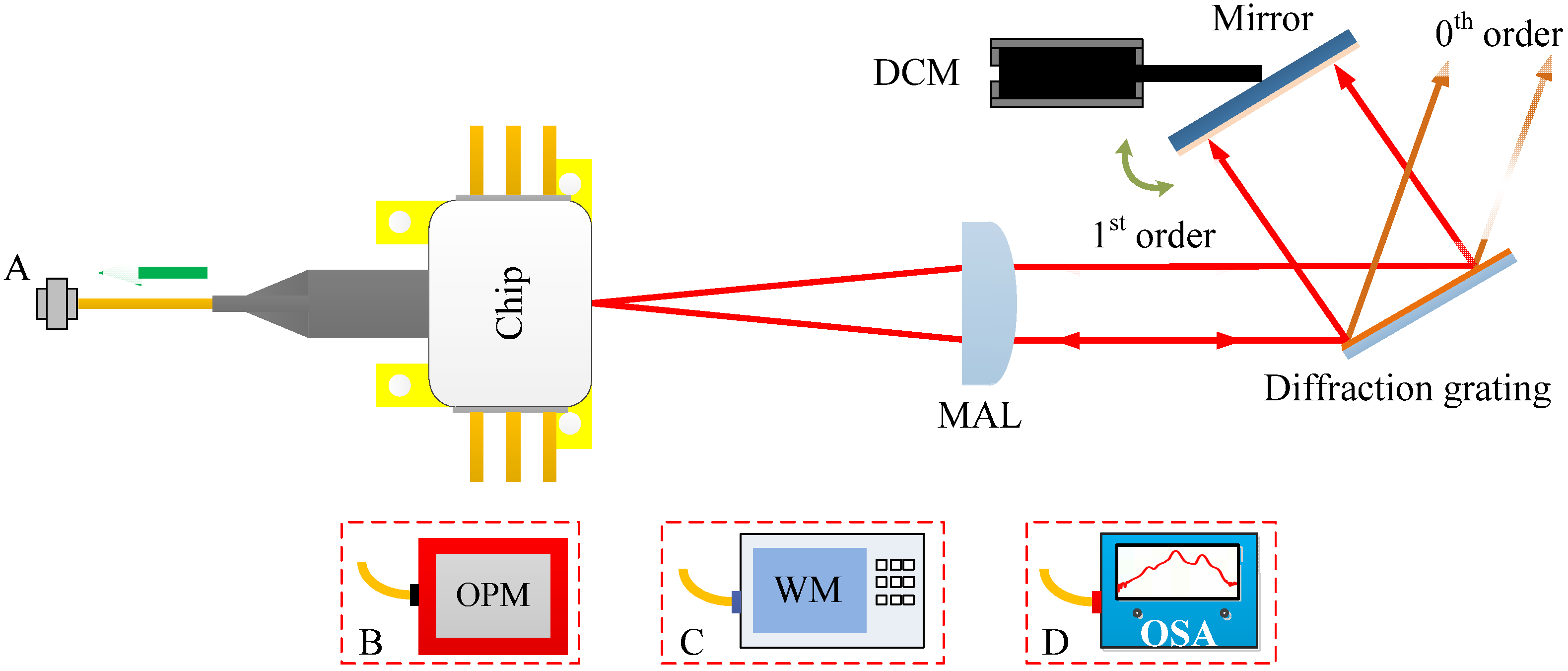

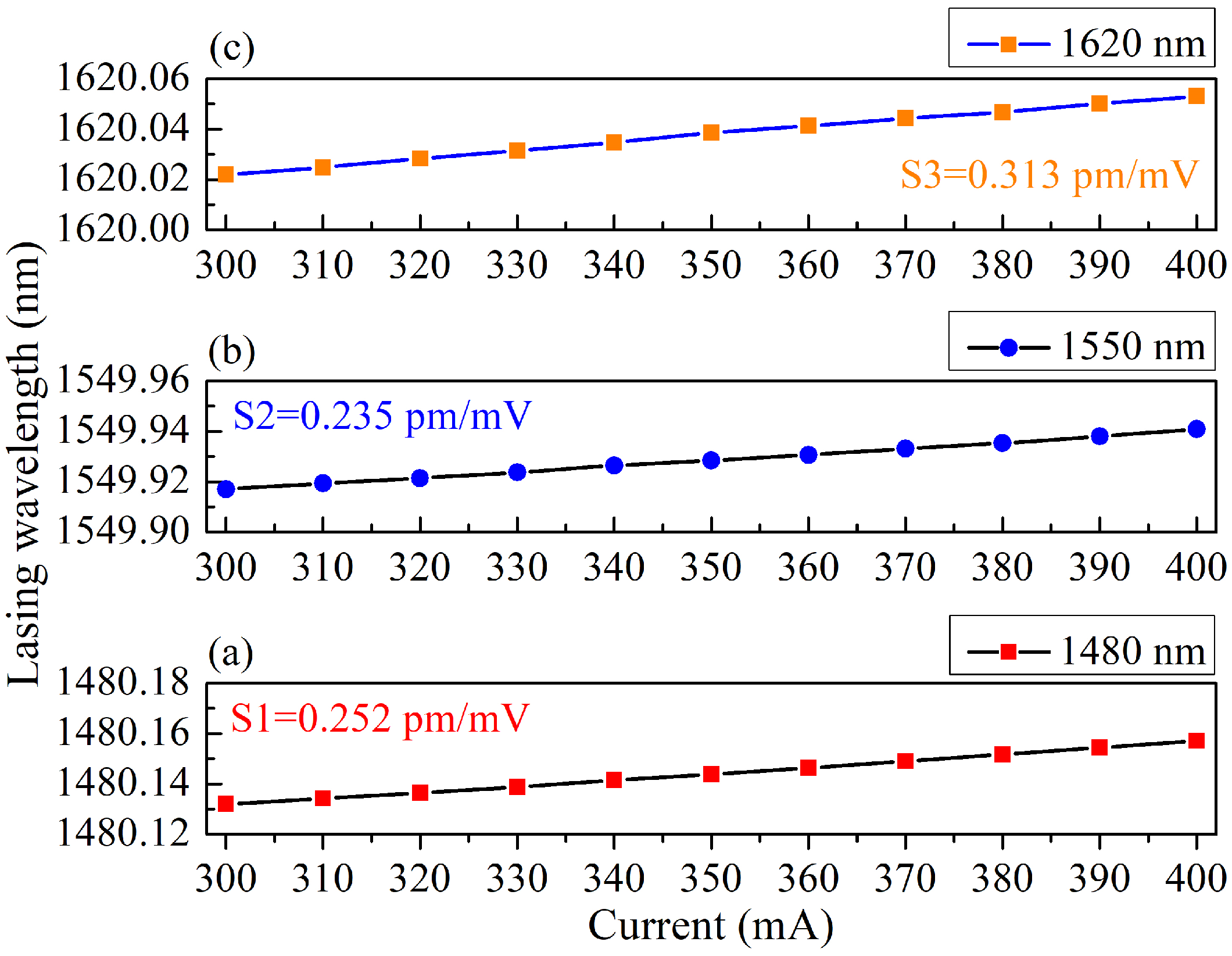
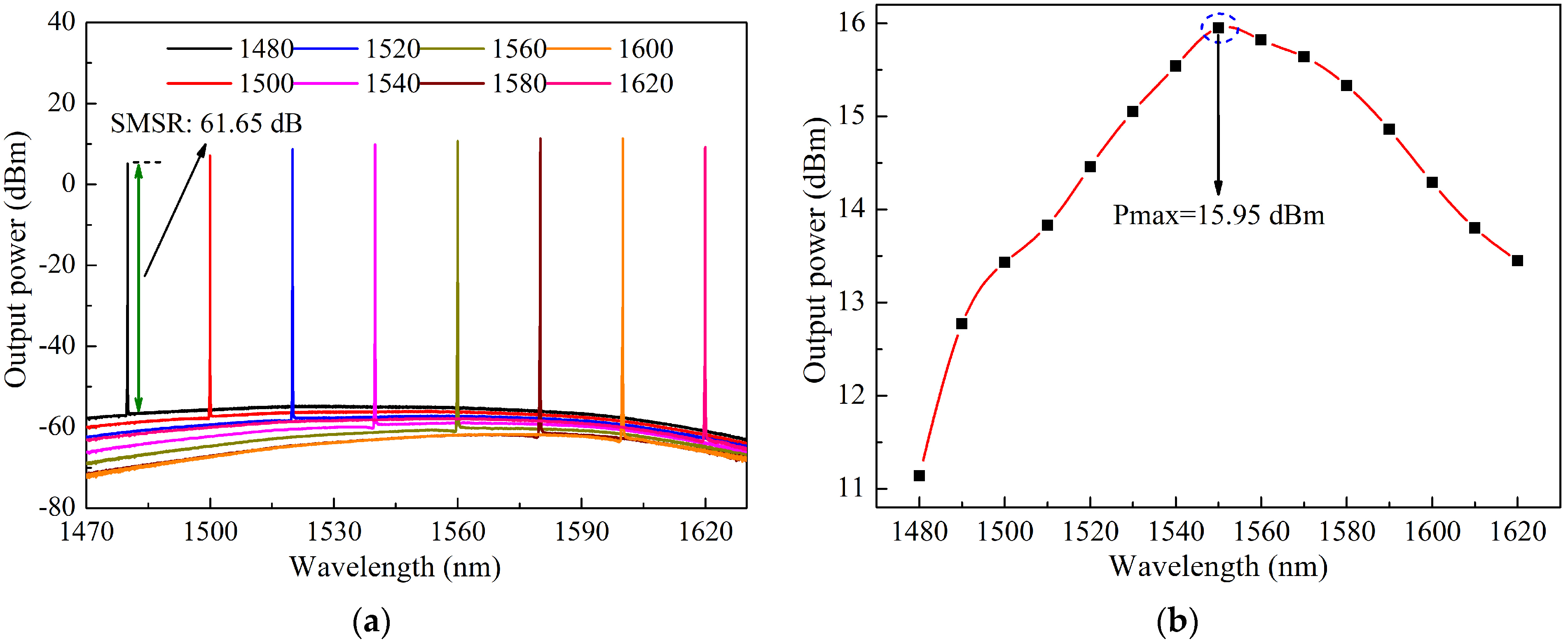

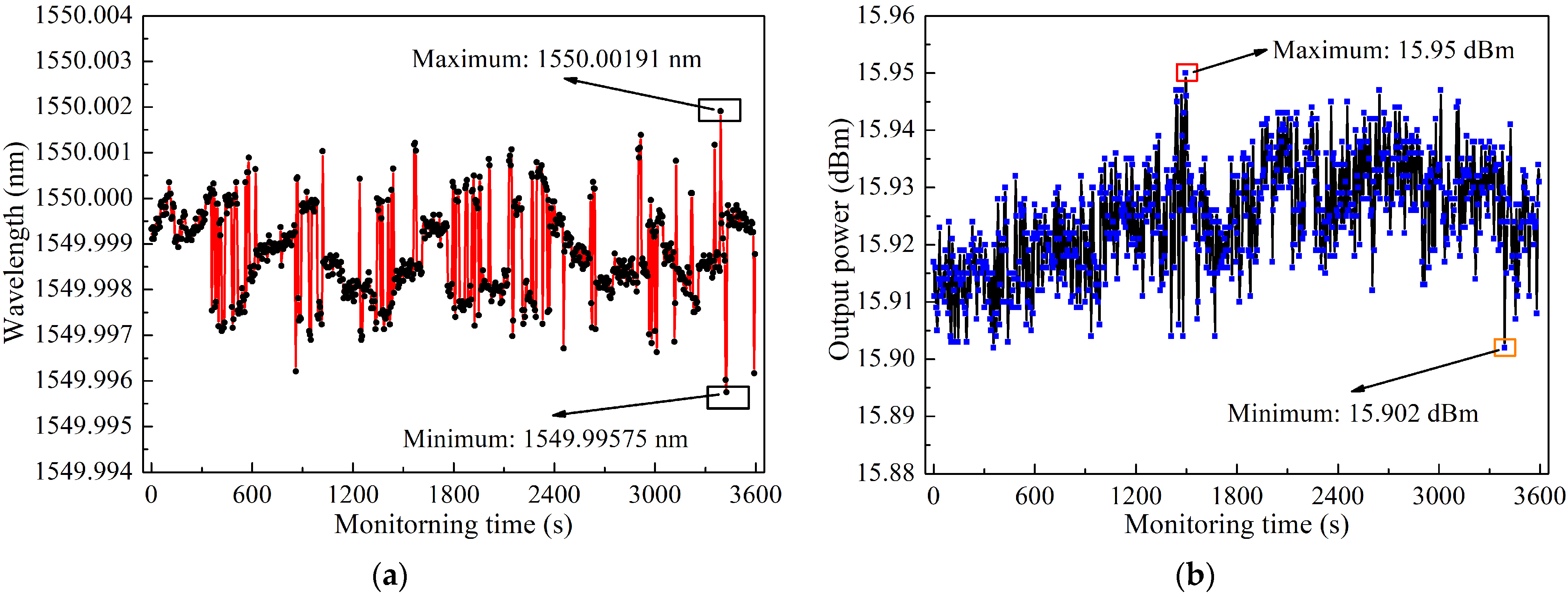
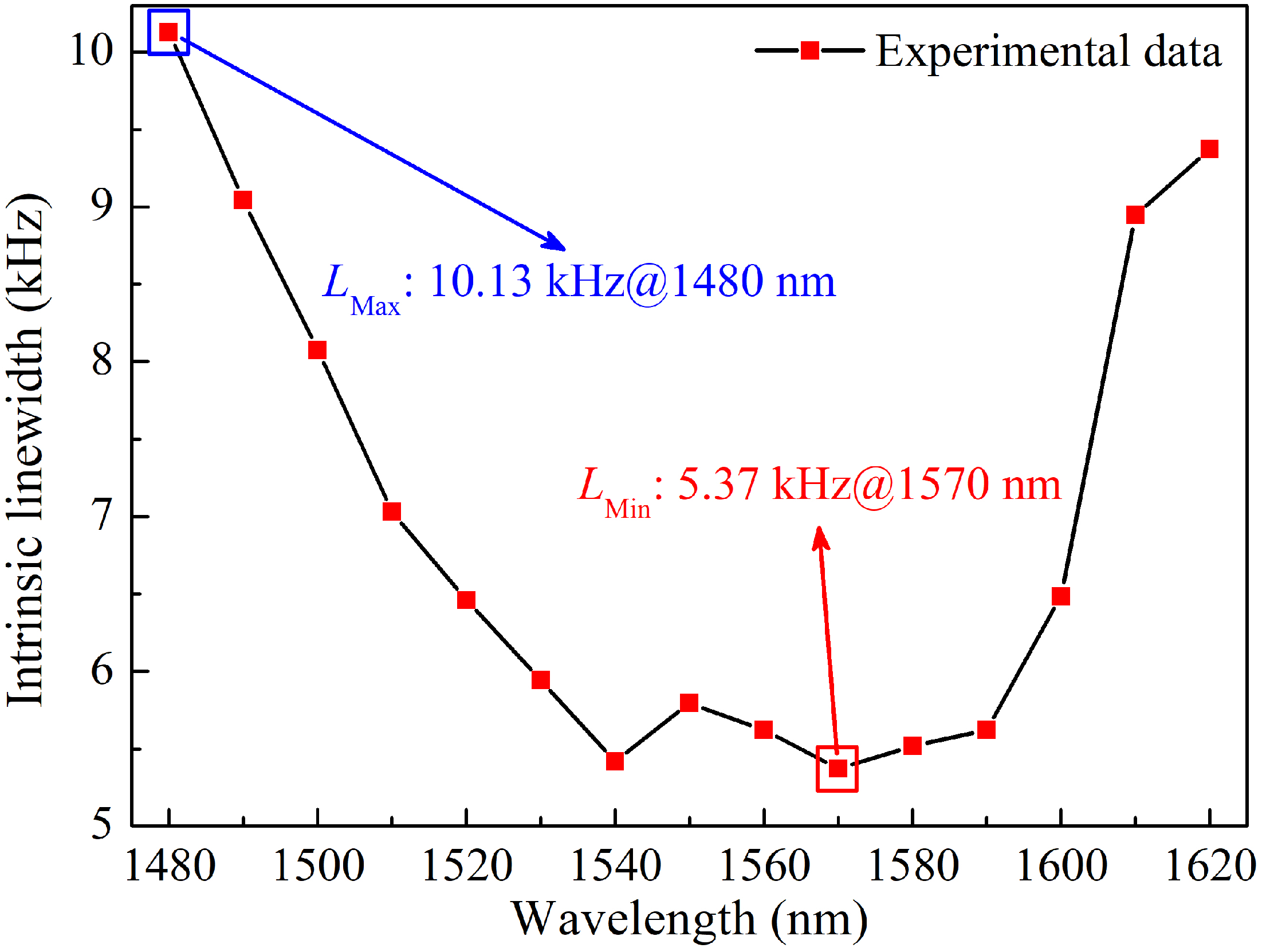
Disclaimer/Publisher’s Note: The statements, opinions and data contained in all publications are solely those of the individual author(s) and contributor(s) and not of MDPI and/or the editor(s). MDPI and/or the editor(s) disclaim responsibility for any injury to people or property resulting from any ideas, methods, instructions or products referred to in the content. |
© 2024 by the authors. Licensee MDPI, Basel, Switzerland. This article is an open access article distributed under the terms and conditions of the Creative Commons Attribution (CC BY) license (https://creativecommons.org/licenses/by/4.0/).
Share and Cite
Sun, J.; Qiu, L.; Liu, L.; Sheng, L.; Cui, Y.; Huang, L.; Pan, M.; Nian, F.; Hu, J. Output Characteristics of External-Cavity Mode-Hop-Free Tunable Laser Source in C+L Band. Photonics 2024, 11, 677. https://doi.org/10.3390/photonics11070677
Sun J, Qiu L, Liu L, Sheng L, Cui Y, Huang L, Pan M, Nian F, Hu J. Output Characteristics of External-Cavity Mode-Hop-Free Tunable Laser Source in C+L Band. Photonics. 2024; 11(7):677. https://doi.org/10.3390/photonics11070677
Chicago/Turabian StyleSun, Jisheng, Liqiang Qiu, Lei Liu, Liwen Sheng, Yudong Cui, Lin Huang, Mengchun Pan, Fushun Nian, and Jiafei Hu. 2024. "Output Characteristics of External-Cavity Mode-Hop-Free Tunable Laser Source in C+L Band" Photonics 11, no. 7: 677. https://doi.org/10.3390/photonics11070677




